February 2004
Conrad-Johnson
Premier 140 Stereo Amplifier: Measurements
All amplifier measurements are performed
independently by BHK Labs. Please click to learn
more about how we test amplifiers there. All measurement data and graphical
information displayed below are the property of SoundStage! and Schneider
Publishing Inc. Reproduction in any format is not permitted.
- Measurements were made with 120V AC line voltage.
- Measurements were made on the left channel.
- Gain: 24.6x, 27.8dB.
- Output noise, 8-ohm load, unbalanced input, 1k-ohm input
termination: wideband 0.255mV, -80.9dBW; A weighted 0.103mV, -88.8dBW.
- AC line current draw at idle: 3.6A.
- Output impedance at 50Hz: 0.98 ohms.
- This amplifier does not invert polarity.
Power output with 1kHz test signal
- 8-ohm load at 1% THD: 98W
- 8-ohm load at 10% THD: 110W
- 4-ohm load at 1% THD: 140W
- 4-ohm load at 10% THD: 160W
General
The Conrad-Johnson Premier 140 tube amp is an
interesting-looking piece. Its physical layout is unusual in that the front and rear
panels are on the sides relative to the enclosed transformer and capacitor cover. This amp
is a stereo push-pull design rated at a nominal 140W. A potentiometer and LED indicator
set output-tube idling current adjacent to each output tube.
High-frequency bandwith, as seen in Chart 1, is unusually
wide for a tube design having a 3dB down point of about 140kHz. The low-frequency response
holds up down to 10Hz nicely at the 1W level of the test. utput impedance is typical of
many tube amplifiers, giving less than a 2dB frequency-response variation with the NHT
dummy speaker load. Total harmonic distortion plus noise and SMPTE IM distortion as a
function of power output and load for a test frequency of 1kHz is plotted in Chart 2. More
power is delivered with the 4-ohm load as that is the default way the amp is delivered.
(The amp can be configured to be optimum for 8- or 16-ohm loads.) Amount of distortion is
admirably low for powers up to perhaps 10-20W, where the kernel of most music resides.
Total harmonic distortion plus noise as a function of frequency at several power levels is
plotted in Chart 3 for a 4-ohm load. Admirable is the relatively low amount of distortion
increase at the higher frequencies. However, distortion does rise considerably below 20Hz
at higher powers. The rise in distortion at low frequencies is a strong function of how
closely the bias is adjusted for equal current in all four output tubes. When I first
measured the left channel of this amp, the rise in distortion at low frequencies was
considerably more pronounced. When I went to more carefully adjust the bias, I found that
two of the four output tubes were down in current compared to the other two. When I really
tweaked the bias so that the red indicator LEDs just went out at 120V AC line input for
all four tubes, the performance of the left channel more closely matched that of the right
channel. Damping factor vs. frequency referred to an 8-ohm load is plotted in Chart 4, and
it is quite consistent over most of the audio range. In the spectral plot of distortion
and noise for a 10W 1kHz signal into a 4-ohm load plotted in Chart 5, the signal
distortion components are dominated by the second and third harmonics with higher-order
harmonics at reduced and decreasing amplitude with frequency. As I have seen in quite a
number of other amplifiers measured, there is quite a bit of 120Hz power-supply hum
modulation around the suppressed fundamental 1-kHz test frequency.
| Chart 1
- Frequency Response of Output Voltage as a Function of Output Loading |
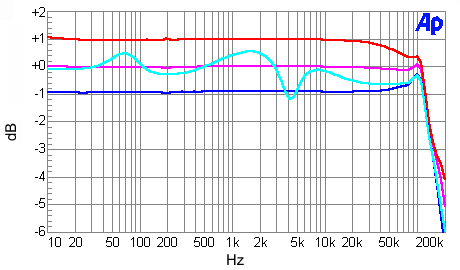
Red line: open circuit
Magenta line: 8-ohm load
Blue line: 4-ohm load
Cyan line: NHT dummy-speaker load
| Chart 2 - Distortion as a Function
of Power Output and Output Loading |
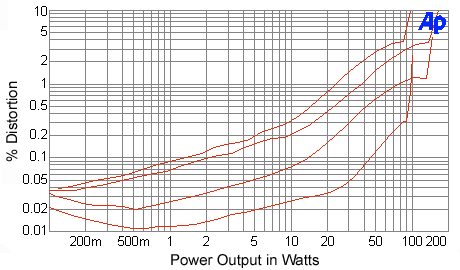
(line up at 10W to determine lines)
Top line: 8-ohm SMPTE IM
Second line: 4-ohm SMPTE IM
Third line: 4-ohm THD+N
Bottom line: 8-ohm THD+N
| Chart 3 - Distortion
as a Function of Power Output and Frequency |
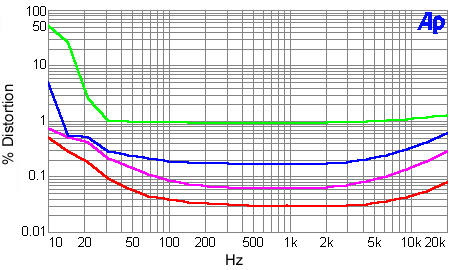
4-ohm output loading
Green line: 140W
Blue line: 30W
Magenta line: 10W
Red line: 1W
| Chart 4 - Damping Factor
as a Function of Frequency |
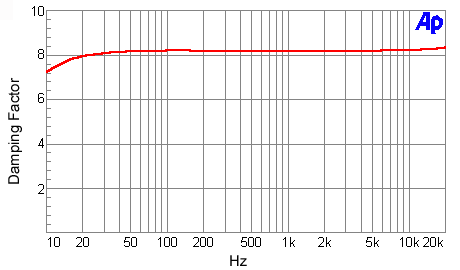
Damping factor = output impedance divided into 8
| Chart 5 - Distortion and
Noise Spectrum |
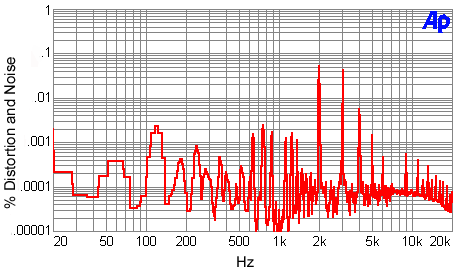
1kHz signal at 10W into an 4-ohm load
|
![[SoundStage!]](../titles/sslogo3.gif) Home Audio
Home Audio ![[SoundStage!]](../titles/sslogo3.gif) All Contents
All Contents



